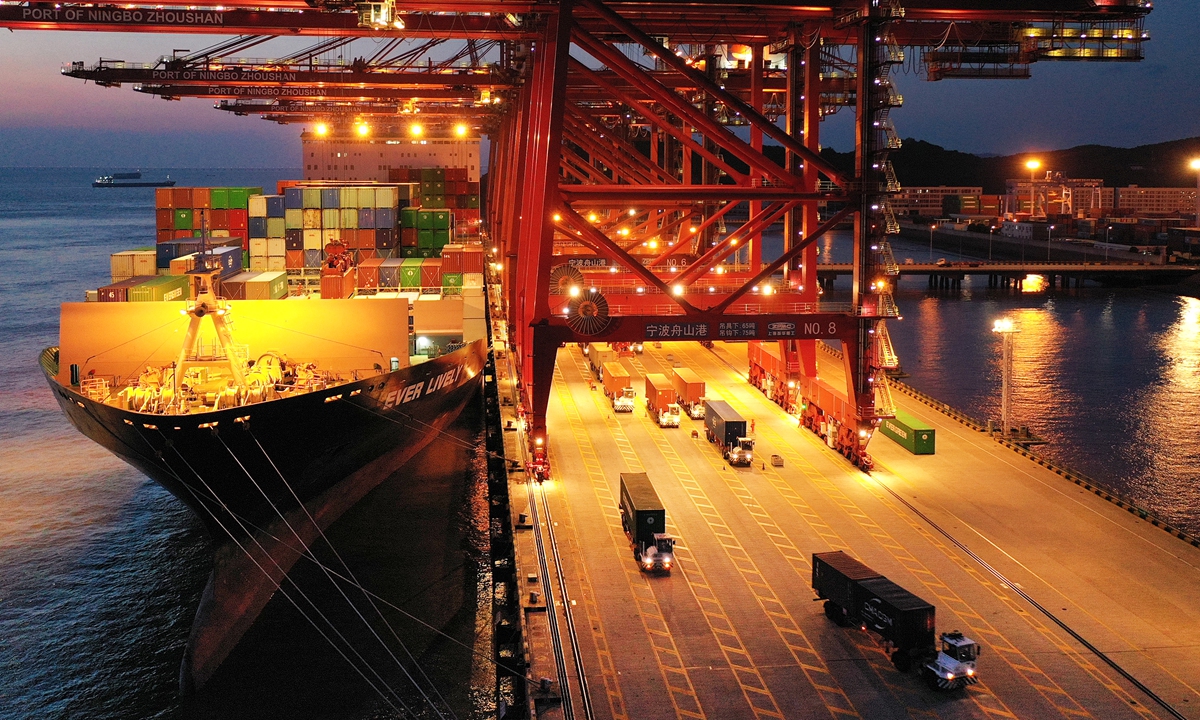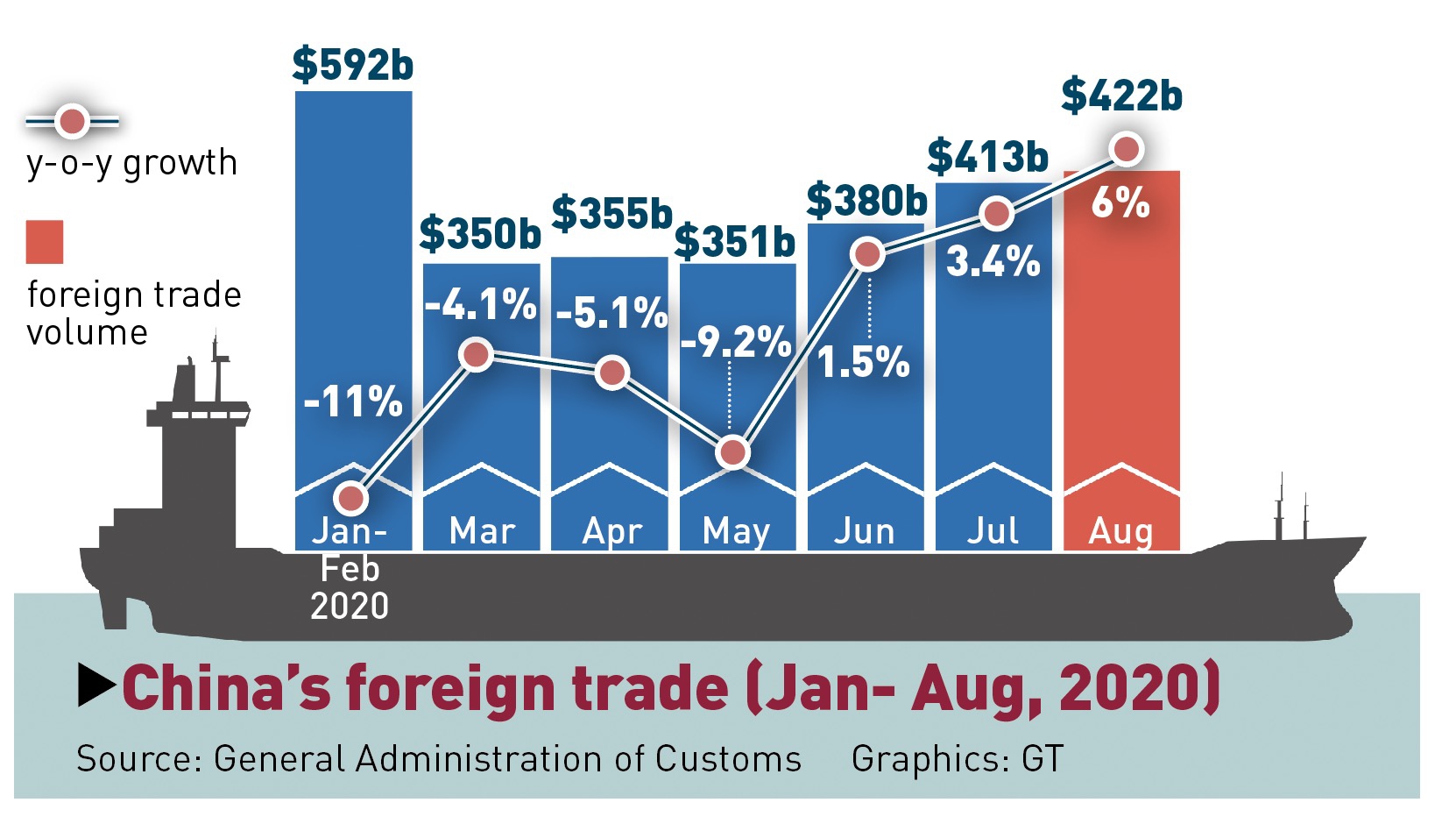China's exports increase 11.6% in August
By GT staff reporters Source: Global Times Published: 2020/9/7 20:58:40
Trade with US contracts, other partners show steady rise

A container vessel offloads its cargo at Ningbo Zhoushan Port in East China's Zhejiang Province on Saturday. Photo: cnsphoto
China recorded sustained and stable improvement in its foreign trade in August, with exports maintaining a strong growth rate of 11.6 percent year-on-year, powered by recovering domestic manufacturing activity and the reopening of more overseas economies.
Analysts said that momentum in the world's second-largest economy will stabilize and promote the recovery of global economic growth in the upcoming months as the coronavirus pandemic eases.
China's foreign trade reached 2.88 trillion yuan ($421.69 billion) in August, up 6 percent year-on-year, according to statistics released on Monday by the General Administration of Customs (GAC).
Exports expanded 11.6 percent to 1.65 trillion yuan, but imports slid 0.5 percent - contrary to economists' belief that imports would edge back into growth. The trade surplus was 416.59 billion yuan, an increase of 74.4 percent, according to the GAC.
The surge in exports recorded the second consecutive month of gains. China's exports showed a surprising surge of 10.4 percent year-on-year in July.

Graphics: GT
"The strong gains in exports were expected, as most countries, except the US, have seen signs of an easing pandemic in recent months, so external demand is recovering," Lian Ping, head of Zhixin Investment Research Institute, told the Global Times on Monday.
Europe and the US reopened various sectors of their economies earlier than expected, partially contributing to the rise in Chinese exports, said Bai Ming, deputy director of the international market research institute at the Chinese Academy of International Trade and Economic Cooperation, a think tank under the Ministry of Commerce.
Domestic manufacturing ability also regained momentum and gradually got back to normal, further empowering export growth, Lian said.
Results of a private survey last week showed that China's manufacturing activity expanded in August at the fastest pace in nearly a decade. The official manufacturing Purchasing Manager's Index (PMI) also showed manufacturing activity improved in August as the country continued to recover from the coronavirus pandemic.
The private Caixin PMI survey focuses on small and medium-sized firms, while official the PMI survey typically polls a large proportion of large and mostly state-owned firms.
"However, certain countries' protectionist restrictions on exports to China, along with a number of countries' limited supply due to the continued suspension of manufacturing, led to a drop in Chinese imports," Bai said.
Lian noted that the weaker-than-expected level of imports indicated that China's domestic demand has yet to recover.
Liu Xuezhi, a macroeconomics expert at the Bank of Communications, said China's economic recovery mainly relies on the resumption of work and production to drive improvement on the production side, but the recovery of demand is weaker than that of production, keeping imports weak relative to exports.
Total foreign trade in the first eight months of 2020 was 20.05 trillion yuan, down 0.6 percent year-on-year. Exports have edged back growth for the year to date, thanks to the solid momentum of July and August. From January to August, exports were up 0.8 percent year-on-year. Meanwhile, imports totaled 9 trillion yuan, a 2.3 percent drop.
China's trade with the Association of Southeast Asian Nations (ASEAN), the EU and Japan increased from January to August, while trade with the US declined. ASEAN, the EU and the US are China's top three trading partners.
ASEAN remained China's biggest trading partner, with trade of 2.93 trillion yuan in the first eight months, up 7 percent year-on-year and accounting for 14.6 percent of China's total foreign trade.
China-US trade sank 0.4 percent to 2.42 trillion yuan, accounting for a 12.1-percent share of China's foreign trade. China's exports to the US were down 0.5 percent, while imports from US rose 0.2 percent.
"Exports to the US fell mainly because the pandemic curbed demand, and tariffs on Chinese products also affected sales to the US," Lian said, adding that China's implementation of the first phase trade deal contributed to the increase in imports from the US.
The world economy may have touched a bottom in the second quarter. As long as the resumption of production continues to accelerate, external demand will revive, and exports will maintain growth, Liu said.
However, there are also uncertainties - for instance, whether there will be further large coronavirus outbreaks - and there is a risk of escalating trade frictions, said Liu.
Bai told the Global Times that China may strive to stabilize foreign trade during the rest of the year through focusing on free trade zones and stabilizing using foreign capital.
During the ongoing 2020 China International Fair for Trade in Services, Beijing Mayor Chen Jining said that the capital will accelerate the creation of a pilot free-trade zone for scientific and technological innovation, to aid the opening-up of the services sector and digital economy.
Posted in: ECONOMY